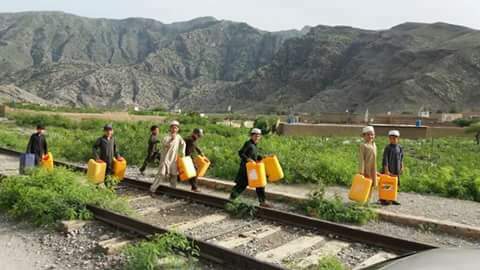
Mehrab Shah AFridi
Asma Bibi, a resident of the Landi Kotal Tehsil of the Khyber district, has to walk miles daily to fetch water for drinking and other usages. She says that just two or three years ago, the well in their house was full of water all the time, “The well not only fulfilled our needs, but the women of the nearby houses also carried water easily. Now the well has dried up which has completely changed our lives.”
The waters-shortage issue in Landi Kotal, a Tehsil in the Khyber district of Khyber Pakhtunkhwa, is worsening day by day while no steps are being taken by the government to solve this core issue. According to local people, dozens of wells have dried up and women are forced to fetch water on their heads from remote areas.
Asma, a 30-year-old local, said that such or similar situations are faced by almost every family in Landi Kotal today. Due to the prolonged drought in the area, the underground water level is declining day by day. Hundreds of wells, like that at Asma Bibi's house, have dried up and hundreds more are on the verge to go dry in the near future.
Also Read: Takhtabai villagers migrating from homes due to water shortage
Complaints of the declining level of the underground water are not limited only to Landi Kotal, but 28 out of 35 districts of Khyber Pakhtunkhwa are facing the same dire situation.
On August 27, 2021, the Federal Ministry of Water Resources, in a report submitted to the Senate, confirmed this and said that the level of underground water in some districts of the province has been falling so fast for the last 10 years that they may face severe drought in the next few years.
In the last decade, the underground water level in the Khyber district has dropped by 74 feet, while in the same period, it has declined by 61.50 feet in the Haripur district.
Similarly, in the districts of Mohmand, Bajaur, and Kurram, its level has decreased by 57.42 feet, 32.79 feet, and 25.75 feet.
Qazi, the Superintendent of the Provincial Public Health Department, said that as a result of the decrease in underground water, around five hundred tube wells installed in different parts of the province have dried up.
Local people of Landi Kotal said they have been wandering for years in search of water, if the government wants, drinking water can be delivered to their doorstep. The problem of water can be solved by revitalizing the old Ali Masjid project, building small rain dams, and launching Shalman Water Supply Scheme, but solving the problems in the tribal areas has not been the priority of the rulers.
Waqas Shinwari, a resident of Perokhel, Landi Kotal, said that the problem of water shortage is prevalent throughout the Khyber region, but water scarcity in the Perokhel area is intense. Many of the small water wells in the area have now dried up and thus the quality of water in most of the wells has deteriorated. The groundwater level in the Perokhel area has gone down due to climate change and thus water is not available in most of the dug wells and tube wells.
He said that most of the people in the area are poor and cannot afford to buy water, and women and children walk long distances to fetch water in extreme weather conditions.
Qazi, however, said there are about 50 big tube wells in the entire Landi Kotal, in which most of the tube wells have solar systems installed because there is a severe problem with electricity in the tribal districts and especially in Landi Kotal, when there is no electricity, then the tube wells are closed.
An estimated 40 large tube wells have been installed with the help of NGOs, and thousands of people benefit from these tube wells, the official added.
Waqas Shinwari said that there are many wells in Shinwari area, and there are tube wells in every house and village. One has to dig fifteen to twenty yards deeper to hit the water table below, so most people have constructed tube wells themselves. However, due to a lack of rainfall, the tube wells of this area are also drying up, he added.
Waqas Shinwari said that the problem of water in Landi Kotal is also because there are no storage dams. When it rains, the water is not stored here and flows into the rivers, he informed.
Jamaat-e-Islami District Khyber General Secretary Murad Hussain Afridi said that storage dams in Landi Kotal can be helpful in storing rainwater. But it is sad to say that our elected representatives have only made promises and have not done practical work yet. Regarding Shalman Water Supply Scheme, he said that this project is there in the papers but nothing has been done in practice. He said that if this scheme is completed, the problem of water supply of 80 percent of the population of Landi Kotal can be solved.
He further said that PC-1 of Shalman Water Supply Scheme was commissioned in May 2021. He said that the estimated cost of the project is Rs 5,534 million. Apart from this, the Landi Khana water supply scheme could not be initiated. He also said that by resuming the British-era project through pipes from Ali Masjid, clean drinking water can be supplied to the large population of Landi Kotal at a low cost as most of the pipes of this project are completely safe, and in their original state.